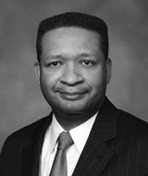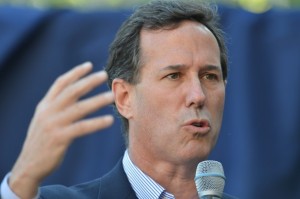 Some post-mortems on Rick Santorum’s partly admirable, partly vexing candidacy: First, his is a campaign that can credibly spend energy on the “what-if” game. That distinguishes him from Herman Cain, Rick Perry, and Michele Bachmann, all of whom were so thin in national campaign skills, or so palpably unprepared to be president, that no assembly of tactics would have gotten them there.
Some post-mortems on Rick Santorum’s partly admirable, partly vexing candidacy: First, his is a campaign that can credibly spend energy on the “what-if” game. That distinguishes him from Herman Cain, Rick Perry, and Michele Bachmann, all of whom were so thin in national campaign skills, or so palpably unprepared to be president, that no assembly of tactics would have gotten them there.
I’ve believed since the night of his Iowa speech that Santorum did have a pathway. It involved owning a unique economic message, one that chastised both Wall Street and Washington for breaching the social compact, and one that recognized that middle class anxiety has cultural and economic roots. He could have so easily broadened that theme by embracing tough education reforms and a crackdown on special interest influence. He could have wielded the Bain Capital card much more credibly than Newt Gingrich.
 For a mix of reasons—the lack of a strategic thinker in his campaign circle, an undisciplined communications style, and way too much time arguing process and electability instead of ideas–Santorum never polished the smart populism that I described above. Instead of becoming the “creative, new ideas” alternative to Romney, he lapsed into the politics of last conservative standing, which after his peak in February, was only good enough for the Deep South and a string of solid seconds. It’s a gambit that might have worked against a Giuliani or a Huntsman; but against a mainstream conservative like Romney, whom the right found acceptable if unexciting, the game plan was too cautious and too uninspiring.
For a mix of reasons—the lack of a strategic thinker in his campaign circle, an undisciplined communications style, and way too much time arguing process and electability instead of ideas–Santorum never polished the smart populism that I described above. Instead of becoming the “creative, new ideas” alternative to Romney, he lapsed into the politics of last conservative standing, which after his peak in February, was only good enough for the Deep South and a string of solid seconds. It’s a gambit that might have worked against a Giuliani or a Huntsman; but against a mainstream conservative like Romney, whom the right found acceptable if unexciting, the game plan was too cautious and too uninspiring.
The next question is whether 2016 will be kinder to him. The comparisons between Santorum and Ronald Reagan in 1976 have been bandied about by Tony Perkins, among others, but they seem strained to me. The results hardly compare: Reagan in 1976 entered the GOP convention effectively tied with a sitting president and as Craig Shirley’s masterful account, “Reagan’s Revolution” describes, it was only a few tactical fumbles that defeated him at that convention (that and Gerald Ford’s smart refusal to let the Great Communicator near the stage before ballots were cast). Santorum never obtained delegate parity with Romney, and the atmospherics of the race seemed genuinely close for all of one week, just before Michigan.
The Reagan insurgency was also built on one man’s supreme skills as a campaigner, and the twelve years he spent motivating the conservative base. Santorum remains largely an unknown to the Republicans who voted for him, a pleasant enough persona who filled a void but would have surely languished if a Perry had been better prepared, or if a Daniels, Barbour or Huckabee had run. Even for the movement conservatives who propelled him along the way, Santorum was more a vehicle than a personal cause. The odds that the same element of the party genuinely prefer him to Marco Rubio, Bobby Jindal, Paul Ryan, or even would be conservative governors like Mike Pence and Ken Cuchinelli, seem improbable.
Lastly, is Santorum’s brand of social conservatism one Republicans will want to emulate in the future? To be sure, the evangelical wing of the Republican Party, which in exit polls was the one constituency that consistently rallied to Santorum, is not about to disappear in four years. But he is unlikely to face an opponent who runs on socially moderate positions, and under no circumstances will he have the field on the social right to himself. Also, for Republicans who are intent on reversing the party’s erosion with educated women, younger voters, and suburban independents, there will be a rush to find a candidate palatable to evangelicals but without Santorum’s paper and video trail.
And it is on this last score where Santorum’s effort boomeranged on conservatives. The cause of religious liberty needs a champion who defends faith institutions from an overreaching government, and who puts that defense in the context of opposing values respecting each other in a pluralistic society. Santorum offered instead an attack on contraception and the sexual freedom it provides—a subject for a pastor not a president. Moreover, the attack validated the liberal fear that the faith-minded are bent on imposing a theological agenda, and that autonomy is the last thing on their mind. It’s a fear with virtually no basis, and one that hints at anti-religious barbs against both Jimmy Carter and John Kennedy, but Santorum’s rhetoric gave it life.
I could go on: stridently denouncing JFK, sniping at college as an elitist conceit, etc. Santorum seemed all too often rooted in a theory of America that labels the left as an immoral, effete place. But in casting his arguments in such melodramatic terms, he made a Santorum nomination much too high risk in a country that rewards politicians who cut into the other side’s base—think Reagan with blue collars and Obama’s upper South moderates in ’08.
It was weird that on a day when Santorum dropped out, the broader public seemed more engaged by the account of a baseball manager flailing around Cuban politics and Fidel Castro. The story was grist for a press that loves the specter of a culture-based fight. It may be that for all of his fortitude and his virtue, Santorum ended up being just another part of our contentious, rambunctious noise, and that his mark will quickly be lost in the wind.









Leave a Reply